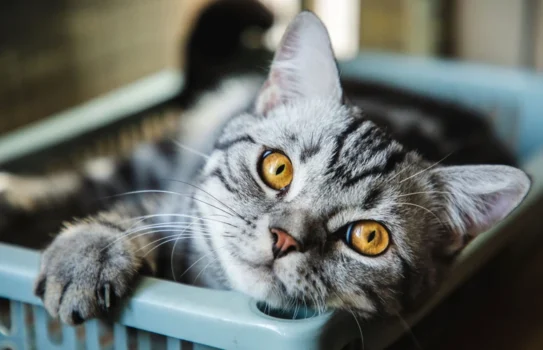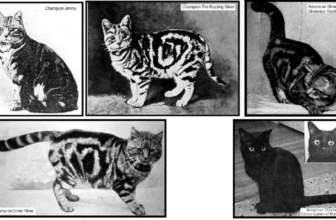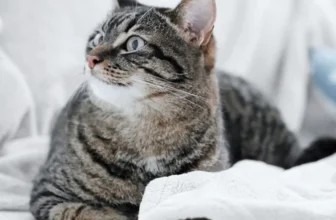Introduction
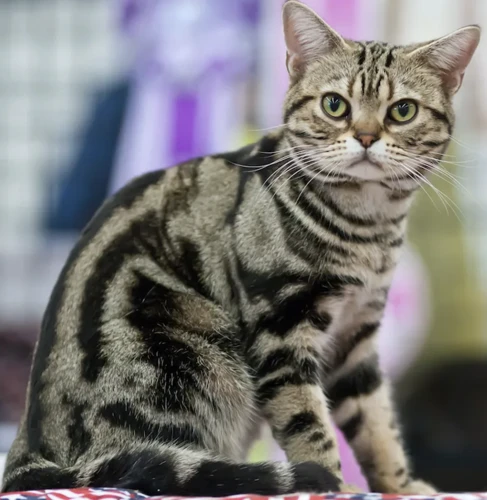
Welcoming a new American Shorthair cat into your home can be an exciting but challenging experience. As a cat owner, it is important to understand that American Shorthairs are intelligent, curious and independent cats that require proper training to develop good behavior habits and maintain a healthy lifestyle. In this article, we will provide you with helpful tips and tricks to train your American Shorthair, from litter box training to addressing common behavioral issues. By following these training methods, you will be able to bond with your furry pal while creating a well-behaved feline companion that is a joy to be around. Let’s get started!
About American Shorthair Cats
One of the most popular breeds in the United States, the American Shorthair cat is beloved for its playful demeanor and adaptability. American Shorthairs are medium to large cats that have broad faces, robust bodies, and short, dense fur that comes in a variety of colors and patterns.
These cats are known for their friendly and affectionate personalities, making them great pets for families with children or other pets. They are also relatively low maintenance and adaptable to different environments.
American Shorthairs have a long and interesting history in the United States. They are descended from the cats brought over by European settlers in the 17th century, who used them as working cats to control pests like rats and mice. Over time, these cats evolved into the American Shorthair breed we know today, with distinct characteristics and traits that set them apart from other breeds.
While American Shorthairs are generally healthy and easy-going cats, they still have their own unique quirks and needs when it comes to training and behavior. For example, they can be prone to certain health issues such as dental problems and obesity, which require careful attention and monitoring by their owners.
American Shorthairs are intelligent and social animals that respond well to positive reinforcement training techniques. By taking the time to properly train and socialize your cat, you can help them develop into a happy, well-adjusted pet that brings joy and companionship to your home.
Litter Training

Litter training your American Shorthair is an essential part of ensuring a stress-free environment for both you and your feline friend. Toilet training your cat can prove to be a challenging process, but with patience and consistency, you can teach your cat to use the litter box without any difficulties. In this section, we’ll provide you with tips and tricks on how to train your American Shorthair to use the litter box, from choosing the right litter box to troubleshooting common litter training issues. Let’s dive in and discover how to help your American Shorthair achieve a well-behaved and litter-trained lifestyle.
Choosing the Right Litter Box
When it comes to choosing the right litter box for your American Shorthair, there are a few important things to keep in mind. The first thing you want to consider is the size of the litter box. American Shorthairs are a medium-sized breed, so you want to make sure the litter box is big enough for your cat to comfortably move around in. In general, a litter box should be at least 1.5 times longer than your cat from nose to tail. It’s always better to go a little larger if you’re not sure.
The second thing to consider is the type of litter box. There are many different types of litter boxes on the market, including open-top, covered, and self-cleaning options. Open-top litter boxes are generally the best option for American Shorthairs because they provide plenty of room and are easy to clean. Covered litter boxes can be a good choice if your cat prefers privacy, but they can also trap odors and make cleaning more difficult. Self-cleaning litter boxes can be a great option for busy owners, but they do require a larger investment.
Next, think about the material of the litter box. Most litter boxes are made from plastic, but there are also options made from wood, metal, and other materials. Plastic litter boxes are the most common and affordable option, but they can also absorb odors over time and might need to be replaced more frequently. Metal litter boxes are durable and easy to clean but can be noisy when your cat scratches around in the litter. Wood litter boxes are eco-friendly and stylish, but they can be harder to clean and can absorb moisture.
Finally, consider the placement of your cat’s litter box. Cats prefer a private and quiet area to do their business, so make sure the litter box is placed in a low-traffic area away from loud noises and other distractions. Ideally, your cat’s litter box should also be placed far away from their food and water bowls.
Choosing the right litter box is an important part of litter training your American Shorthair, so take your time and choose the option that will work best for your cat and your household.
Introducing Your Cat to the Litter Box
Before introducing your American Shorthair to their litter box, it’s important to select the right type of litter. Many cats prefer unscented, clumping litter, while others may prefer a different texture. It might take some trial and error to find the right litter for your cat. Once you have the right type of litter, follow these steps for introducing your cat to their litter box:
- Choose the right location: Select a quiet, low-traffic area for the litter box. Your cat needs privacy while using the box, and loud noises or frequent interruptions can cause them to avoid it entirely.
- Show your cat the litter box: Bring your cat to the litter box and let them sniff it. They may jump in and start using it right away, or they may show no interest. Either way, it’s important to give them time to get comfortable with the box and its location.
- Encourage your cat to use the litter box: If your cat doesn’t use the litter box on their own, gently place them in it and scratch their front paws in the litter to show them what to do. Repeat this process several times a day until they start using the box independently.
Remember, litter training can take time, so be patient with your pet. If they continue to avoid the litter box, there may be an issue you need to address. For example, they might be afraid of the litter box, or they may not like the type of litter you’ve chosen. In cases like this, refer to ‘/american-shorthair-behavior-solutions/’ for tips on how to address common litter box issues.
Common Litter Training Issues and How to Solve Them
When litter training your American Shorthair, you may encounter some common issues that can make the process difficult. Here are some of the most common litter training issues and how to solve them:
1. Refusal to Use the Litter Box
If your American Shorthair refuses to use the litter box, it could be due to several reasons. One possible reason is that the litter box is not clean enough. Cats are naturally clean animals and don’t like to use a dirty litter box. Make sure to scoop out the litter box daily and thoroughly clean it once a week.
Another reason could be that your cat doesn’t like the type of litter you’re using. Try switching to a different type of litter to see if that solves the problem. You can also try using a different litter box, as some cats prefer covered versus uncovered litter boxes.
If your cat is still refusing to use the litter box, it’s possible that there is an underlying health issue. Contact your veterinarian to rule out any medical conditions.
2. Litter Box Aversion
If your American Shorthair has developed litter box aversion, it’s important to address it as soon as possible. Signs of litter box aversion include avoiding the litter box, meowing excessively, and urinating or defecating outside of the litter box.
To solve this issue, start by thoroughly cleaning the litter box and changing the litter. Provide multiple litter boxes in different locations to give your cat more options. Make sure the litter boxes are easily accessible and not near noisy or high-traffic areas.
If your cat continues to avoid the litter box, consult with your veterinarian to rule out any underlying medical issues.
3. Spraying or Marking
Unneutered male American Shorthairs may spray or mark their territory outside of the litter box. The best solution for this issue is to have your cat neutered. Neutering can significantly reduce a cat’s likelihood of spraying or marking.
If your cat is already neutered and still spraying or marking outside of the litter box, it’s important to address the underlying cause. Your cat may be feeling stressed or anxious, or there may be too much competition for resources among your cats. Consult with your veterinarian or a cat behaviorist to determine the best course of action.
By addressing these common litter training issues and finding effective solutions, you can ensure a happy and healthy relationship with your American Shorthair.
Positive Reinforcement Training
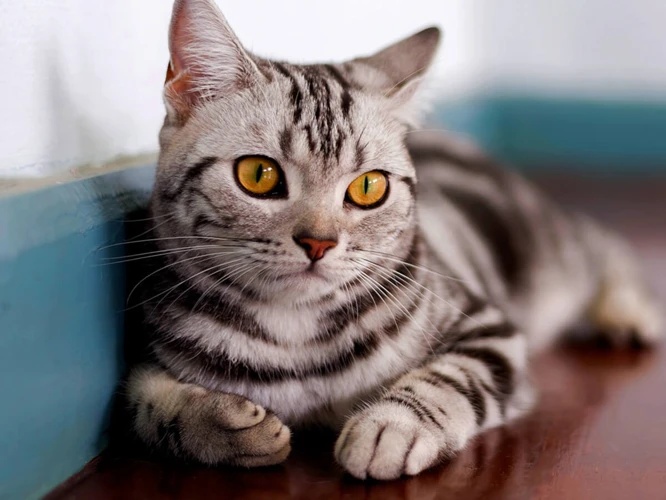
When it comes to training your American Shorthair, positive reinforcement is a highly effective approach that emphasizes rewarding good behavior instead of punishing bad behavior. This method of training helps to create a bond of trust and mutual respect between you and your furry friend. In this section, we will explore different positive reinforcement techniques that you can use to help your cat learn and obey basic commands. Some of these techniques include clicker training, the use of treats and toys, and teaching basic commands. By using these positive training methods, you can help your American Shorthair become a well-behaved and happy companion.
Teaching Basic Commands
Teaching basic commands to your American Shorthair is an essential part of their training. Some basic commands include ‘come’, ‘sit’, ‘stay’, and ‘down’. These commands can help you control your cat’s behavior and ensure their safety in certain situations.
Here are some tips on teaching your American Shorthair basic commands:
- Start by using positive reinforcement. Use treats and verbal praise to encourage your cat when they follow your commands.
- Use short, simple phrases to give commands. Repeat the command several times until your cat follows it.
- Be consistent with your commands. Use the same phrasing for each command and reward your cat every time they follow it.
- Keep training sessions short and frequent. Cats have a short attention span, so it’s better to have multiple short training sessions throughout the day.
- Gradually increase the difficulty of the commands as your cat gets better at following them.
- Use a clicker to mark your cat’s behavior when they follow your commands correctly.
Remember that every cat learns at their own pace, so be patient and consistent with your training. If you experience any behavioral issues during training, such as aggression, vocalizations, or playfulness, refer to our previous articles on understanding aggressive behavior in American Shorthairs, playtime tips for American Shorthairs, and common vocalizations of American Shorthairs, respectively, for additional guidance.
Clicker Training for Cats
Clicker training is a popular and effective method for training cats and other animals. It uses a small handheld device that makes a clicking sound to mark desired behavior. The device, called a clicker, is paired with treats or rewards, so the cat understands that the click means they have done something right.
The Benefits of Clicker Training for American Shorthair Cats
There are several benefits to using clicker training with American Shorthair cats. First, it can help with bonding and trust-building. When a cat learns that certain behavior will result in a click and a treat, they begin to associate their owner with positive experiences. This can help them become more relaxed and confident around their owner.
Second, clicker training can be used to teach a wide variety of behaviors, from sit and stay to tricks and commands. It is also an excellent tool for addressing problem behaviors such as scratching or biting. By using positive reinforcement, the cat learns what is expected of them in a fun and rewarding way.
| Steps in Clicker Training | Explanation |
|---|---|
| 1. Charge the Clicker | Before you start training, you need to charge the clicker. This means repeatedly clicking the device while giving your cat treats until they learn to associate the sound with something positive. |
| 2. Start with Simple Behaviors | To begin, choose a simple behavior that your cat is likely to perform naturally, such as touching their nose to your hand. Click the device as soon as they perform the behavior, and immediately give them a treat. |
| 3. Shaping the Behavior | Once your cat understands the concept of clicker training, you can start shaping specific behaviors. This involves breaking the behavior down into small steps, rewarding each step along the way. |
| 4. Be Consistent | Consistency is key in clicker training. Always use the same signal (the click) and the same rewards (treats) to avoid confusing your cat. |
| 5. Keep Training Sessions Short | Cats have short attention spans, so keep training sessions brief (5-10 minutes) and always end on a positive note. |
Conclusion
Clicker training is an excellent method for training American Shorthair cats. It promotes bonding, teaches new behaviors, and addresses common behavior problems. By following these steps and being patient and consistent, you can train your American Shorthair using positive reinforcement and make it a fun and rewarding experience for both you and your cat. For more information on addressing behavioral issues like aggression, scratching or vocalizations, visit our page on Understanding Aggressive Behavior in American Shorthairs. Or, if you’re looking for play ideas for your American Shorthair, check out our page on Play Ideas for American Shorthairs.
Using Treats and Toys to Motivate Your Cat
When it comes to positive reinforcement training, using treats and toys can be a great way to motivate your American Shorthair. High-value treats like cooked chicken or freeze-dried meat can be particularly effective in getting your cat’s attention and cooperation during training sessions. Just be sure to use them sparingly to avoid overfeeding your cat.
In addition to using treats, toys can also be a great way to motivate your cat during training. Interactive toys like feather wands or laser pointers can be used to encourage your cat to perform specific behaviors, such as jumping or chasing. When your cat successfully completes the desired behavior, reward them with a treat.
However, it’s important to remember that not all cats will respond to the same treats or toys. Experiment with different options to see what your cat responds to best. Additionally, pay attention to your cat’s individual preferences and adjust your training techniques accordingly.
Remember, training should always be a positive experience for your cat. Avoid using punishment or negative reinforcement, as this can cause anxiety and stress in your cat. Instead, focus on rewarding your cat for desired behaviors and using positive reinforcement to encourage them to continue to behave well.
For more information on the vocalizations of American Shorthairs, check out our article on vocalizations in American Shorthairs.
| Treats | Toys |
|---|---|
| Cooked chicken | Feather wands |
| Freeze-dried meat | Laser pointers |
| Canned tuna | Interactive puzzle toys |
Leash Training
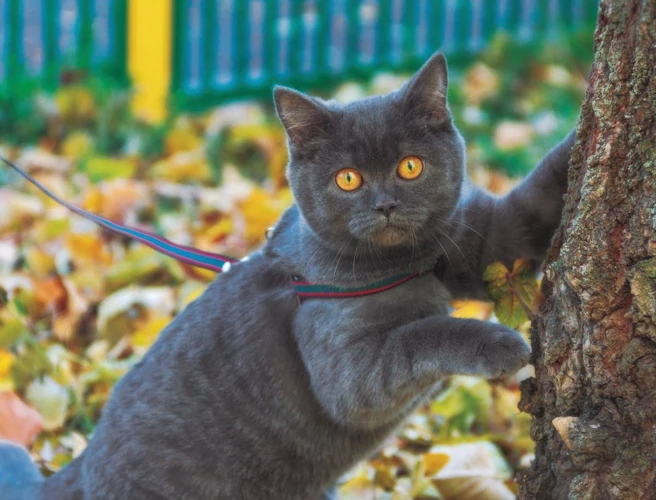
Walking your cat on a leash may sound odd at first, but it can provide a safe and stimulating outdoor experience for your American Shorthair. With proper leash training, your furry friend can enjoy the great outdoors while staying protected from potential dangers. But where do you start? How do you choose the right leash and harness? And is it possible to train a cat to walk on a leash like a dog? In this section, we’ll explore the ins and outs of leash training for cats and provide you with some tips and tricks for getting started.
Choosing the Right Leash and Harness
When it comes to leash training your American Shorthair, finding the right leash and harness is crucial to keeping your cat safe and comfortable. Here are some tips to help you choose the appropriate equipment:
- Size: The leash and harness should fit your cat snugly but not be too tight. Make sure to measure your cat’s girth and neck before purchasing to ensure a proper fit.
- Material: Look for a high-quality, durable material that is comfortable for your cat to wear. Avoid materials that may irritate or chafe your cat’s skin.
- Type: Consider the type of harness best suited for your cat’s temperament and behavior. Some cats may do better with a vest-style harness, while others may prefer a traditional harness.
- Visibility: Choose a harness with reflective strips or bright colors to make your cat more visible to passing cars and pedestrians.
Taking the time to choose the right harness and leash for your American Shorthair can make all the difference in the success of your leash training efforts. Keep in mind that some cats may need time to adjust to wearing a harness and leash, so patience and positive reinforcement are key.
Gradual Introductions to Walking on a Leash
Gradual Introductions to Walking on a Leash
Walking on a leash may be a foreign concept to your American Shorthair, so it’s crucial to introduce them to it gradually. Here are some steps to ensure a successful leash training:
- Start Indoors: Begin by attaching a leash and harness to your cat while indoors and allowing them to explore without any tension on the leash. This will help them get used to the feeling of wearing a leash and harness.
- Practice Short Walks: Once your cat is comfortable with the leash and harness, try taking them on short walks around the house or apartment. Keep the walks brief at first, and gradually increase the duration as your cat becomes more comfortable.
- Offer Treats and Positive Reinforcement: As you take your cat on walks, make sure to offer treats and verbal praise as positive reinforcement. This will encourage them to associate walking on a leash with positive experiences.
- Patience is Key: If your cat seems nervous or resistant to leash training, take a step back and allow them more time to adjust. It’s essential to be patient and not rush the process.
- Graduate to Outdoors: Once your cat is comfortable walking on a leash indoors, you can start taking them outside for walks. Begin in a quiet and controlled environment and avoid busy streets or crowded areas.
By following these gradual steps, you can effectively train your American Shorthair to walk on a leash. Remember, patience and positive reinforcement are key to success.
Dealing with Outside Distractions
When it comes to leash training your American Shorthair, dealing with outside distractions can be a common challenge. It’s important to remember that cats are naturally curious creatures and may want to investigate their surroundings, leading to pulling on the leash or getting distracted.
Here are some tips to help you deal with outside distractions during leash training:
| Tip | Description |
|---|---|
| Find a quiet area | When starting out with leash training, it’s best to find a quiet area with minimal distractions. This will help your cat to focus on the training rather than being overwhelmed by new sights and sounds. |
| Use treats to keep your cat focused | Using treats as a motivator during training can be helpful in keeping your cat focused and engaged. Keep some small treats in your pocket to reward your cat for good behavior and encourage them to stay on track. |
| Avoid crowded areas | Crowded areas with lots of people and other animals can be overwhelming for your cat and make it difficult to leash train. Stick to quieter areas where there are fewer distractions so that you can build your cat’s confidence before moving on to busier environments. |
| Stay calm and patient | It’s important to stay calm and patient during leash training. Yanking on the leash or getting frustrated with your cat can cause them to become stressed and resist the training. Take it slow and be encouraging, offering treats and praise for good behavior. |
Dealing with outside distractions during leash training can be a challenge, but with the right approach and patience, you can successfully train your American Shorthair to walk on a leash in a variety of environments.
Behavioral Training
It’s not uncommon for even the most well-behaved cats to develop problem behaviors. Fortunately, with a little bit of patience and the right approach, many behavioral issues can be addressed and corrected. In this section, we’ll explore tips and tricks for training your American Shorthair to overcome common behavioral issues. From litter box problems to scratching and biting, we’ll cover a range of issues and provide guidance on how to resolve them in a positive and effective way.
Addressing Common Behavioral Issues
As a cat owner, you may encounter some common behavioral issues with your American Shorthair. These can include things like ignoring commands, scratching furniture, and being aggressive towards people or other pets. However, with some patience and the right approach, you can address and correct these issues. Here are some tips to help you deal with common behavioral problems in your American Shorthair:
- Ignoring commands: If your American Shorthair is ignoring your commands, it may be because they haven’t been properly trained or they are distracted. To address this issue, start with basic obedience training using treats and positive reinforcement. Be patient and repeat the training frequently, gradually increasing the level of difficulty as your cat progresses. Use high-volume keywords like “American Shorthair training” and “positive reinforcement” to guide the readers to the main topic and optimize article for further SEO.
- Scratching furniture: Scratching is a natural behavior for cats, but it can be destructive to your furniture. To redirect your cat’s scratching behavior, provide them with appropriate scratching posts and toys. Encourage your cat to use these tools by placing them near areas where your cat likes to scratch. You can also try using deterrents like double-sided tape or citrus scents to keep your cat away from your furniture.
- Aggression towards people or pets: If your American Shorthair is displaying aggressive behavior towards people or other pets, it may be due to fear, territorialism, or lack of socialization. To address this issue, start by identifying the triggers that cause your cat to become aggressive. Then slowly expose your cat to those situations in a controlled environment. Use toys and treats to distract and redirect your cat’s attention. You can also try using pheromone sprays to calm your cat and improve their behavior towards people and other pets.
Remember, every cat is different and may respond differently to training techniques. It’s important to be patient and persistent in your training efforts. With time and dedication, you can correct behavioral issues in your American Shorthair.
Litter Box Problems
Litter box problems are a common issue among cat owners, but they can be resolved with some patience and effort. Here are some potential problems you may encounter and tips on how to solve them:
Litter Box Avoidance:
If your American Shorthair is avoiding the litter box altogether, it’s important to consider the location and type of litter box you’re using. Make sure the box is in a quiet, private location and that it is large enough for your cat to move around comfortably. Additionally, cats can be picky about the type of litter they use, so try experimenting with different textures and scents until you find one that they prefer.
Urinating Outside the Litter Box:
If your cat is urinating outside of the litter box, this may be a sign of a medical issue, so it’s important to consult with a veterinarian first to rule out any underlying health concerns. Once any medical issues are ruled out, consider if the litter box is being kept clean enough or if your cat prefers a different type of litter. You may also need to add additional litter boxes to your home to accommodate your cat’s needs.
Defecating Outside the Litter Box:
If your cat is defecating outside of the litter box, again, it’s important to first rule out any medical issues with a veterinarian. From there, consider if the litter box is being kept clean enough and if it is the right size for your cat. Additionally, some cats prefer to have a separate box for urination and defecation, so adding an additional box may help.
Over-Scratching the Litter Box:
Some cats may scratch excessively at the litter box, which can create a mess and damage the box. If this is the case, try using a litter mat under the box to catch any excess litter and consider using a litter box with a solid cover to prevent scattering. Additionally, make sure you are scooping the litter box regularly to keep it clean.
By addressing these common litter box problems, you can ensure a happy and healthy environment for both your American Shorthair and yourself.
Scratching and Clawing
Scratching and clawing are natural behaviors for cats and are necessary for their physical and mental well-being. However, it can also be destructive to your furniture and belongings. It’s essential to train your American Shorthair to scratch appropriate surfaces. Here are some tips and tricks to help with this particular behavioral issue:
- Provide appropriate scratching surfaces: Cats prefer different types of scratching surfaces, and it’s essential to provide a variety of materials such as sisal, cardboard, or carpet. Experiment with different textures and sizes to find what your cat likes.
- Introduce the scratching surface: Place the scratching post or board in an area where your cat spends most of their time. You can also apply catnip or use a toy to attract them to the surface.
- Redirect: When you catch your cat scratching the wrong surface, gently redirect them to the appropriate one. Use positive reinforcement like treats or praise to encourage them to use the scratching surface.
- Avoid punishment: Punishment can cause stress and anxiety in cats, leading to more destructive behavior. Instead, provide positive reinforcement to promote good scratching behavior.
- Trim their claws: Keeping your cat’s claws trimmed can prevent them from causing damage to your furniture and belongings. Regular trimming can also make scratching more comfortable for your cat.
Remember, training your American Shorthair to scratch appropriately takes patience and consistency. With proper training, you can encourage good scratching behavior and prevent destructive behavior.
Biting and Aggression
Biting and aggression can be a serious issue with some American Shorthair cats. It’s important to address these behaviors early on to prevent them from escalating. Here are some tips on how to deal with biting and aggression in your cat:
| Tip | Explanation |
|---|---|
| 1. Don’t use physical punishment | Using physical punishment, such as hitting or spanking, will only increase the aggression in your cat and damage your relationship with them. It’s important to use positive reinforcement techniques instead. |
| 2. Identify the trigger | Is your cat biting or acting aggressive towards a certain person, animal, or object? Identifying the trigger can help you find a solution to the problem. |
| 3. Redirect their behavior | When you notice your cat getting aggressive, try redirecting their behavior to a more appropriate outlet, such as a scratching post or toy. |
| 4. Use positive reinforcement training | Teach your cat alternative behaviors through positive reinforcement training. For example, reward them with treats or praise when they use their scratching post instead of furniture. |
| 5. Consult with a veterinarian or behaviorist | If your cat’s biting and aggression is serious or persistent, it’s important to consult with a veterinarian or behaviorist who can help you develop a plan to address the issue. |
Remember, biting and aggression can be a serious issue and should be addressed as soon as possible. Identifying the trigger, redirecting their behavior, and using positive reinforcement training can all help you address the issue and improve your relationship with your American Shorthair cat.
Conclusion
As a cat owner, it’s important to keep in mind that training your American Shorthair is an ongoing process that requires patience and consistency. With time and effort, you can raise a well-behaved companion that brings joy to your life. Now that you have learned the fundamentals of training your American Shorthair, it’s time to put your knowledge to the test! Utilize the tips and tricks shared in this guide to establish a positive and healthy relationship with your furry friend. Remember, training takes time to yield results, so don’t be discouraged if you encounter setbacks along the way. With dedication and persistence, both you and your American Shorthair can reap the rewards of successful training.
Review of Training Tips and Tricks for Your American Shorthair
As a summary, let’s review some of the most important tips and tricks for training your American Shorthair cat.
| Training Area | Tips and Tricks |
|---|---|
| Litter Training | Choose a litter box that suits your cat’s size and preferences, introduce the box gradually, and address common issues such as litter preference, box location, and cleanliness. |
| Positive Reinforcement Training | Use rewards, toys, and affection to encourage your cat to perform desired behaviors such as sitting, coming, and using a scratching post. Use a clicker to mark the right action, and avoid punishment or negative reinforcement. |
| Leash Training | Choose a comfortable harness and leash, and introduce them gradually to your cat indoors. Practice walking on a leash indoors before going outdoors. Use treats and praise to reward good behavior and adjust to distractions such as noise and people. |
| Behavioral Training | Observe your cat’s behavior closely and address issues such as litter box problems, scratching, biting, or aggression early. Use redirection, positive reinforcement, and professional help if needed. Provide enough exercise, attention, and mental stimulation to prevent boredom or stress. |
By using these tips and tricks, you can help your American Shorthair become a well-behaved and happy companion. Remember to be patient, consistent, and positive, and adapt your training methods to your cat’s individual needs and personality. With time and effort, you can train your cat to enjoy learning and interacting with you, and to make both of your lives more enjoyable and fulfilling.
Frequently Asked Questions
Q: How long does it typically take to litter train an American Shorthair?
A: Litter training can take anywhere from a few days to a few weeks depending on the cat’s age and previous experiences.
Q: What should I do if my American Shorthair is resistant to using the litter box?
A: It’s important to rule out any medical issues first, but then consider changing the litter or litter box type and location, and providing positive reinforcement for using the litter box.
Q: Can American Shorthairs be trained to do tricks?
A: Yes, with patience and positive reinforcement training, American Shorthairs can be taught to do tricks such as sitting, high-fiving, and playing fetch.
Q: Are American Shorthairs good candidates for leash training?
A: Yes, American Shorthairs can be trained to walk on a leash, but it’s important to start slow and gradually introduce them to the concept.
Q: How can I stop my American Shorthair from scratching up my furniture?
A: Providing appropriate scratching surfaces, such as scratching posts, and using positive reinforcement training to redirect their scratching behavior can help prevent damage to furniture.
Q: Is it possible to train an American Shorthair to stop biting?
A: Yes, with patience and positive reinforcement training, American Shorthairs can be trained to stop biting and exhibit more appropriate play and socialization behavior.
Q: How much exercise does an American Shorthair need?
A: American Shorthairs benefit from regular play and exercise, but their exact needs can vary based on age and individual energy levels.
Q: Can American Shorthairs be trained to coexist peacefully with other pets or children?
A: Yes, with proper socialization and training, American Shorthairs can learn to peacefully coexist with other pets and children in the same household.
Q: Can training help with an American Shorthair’s separation anxiety?
A: Yes, training can help alleviate separation anxiety in American Shorthairs by providing them with positive reinforcement and gradually increasing the time they’re left alone.
Q: What is the most important thing to keep in mind when training an American Shorthair?
A: Consistency and positive reinforcement are key when training an American Shorthair. Avoid punishing or yelling at them and focus on rewarding good behavior.

